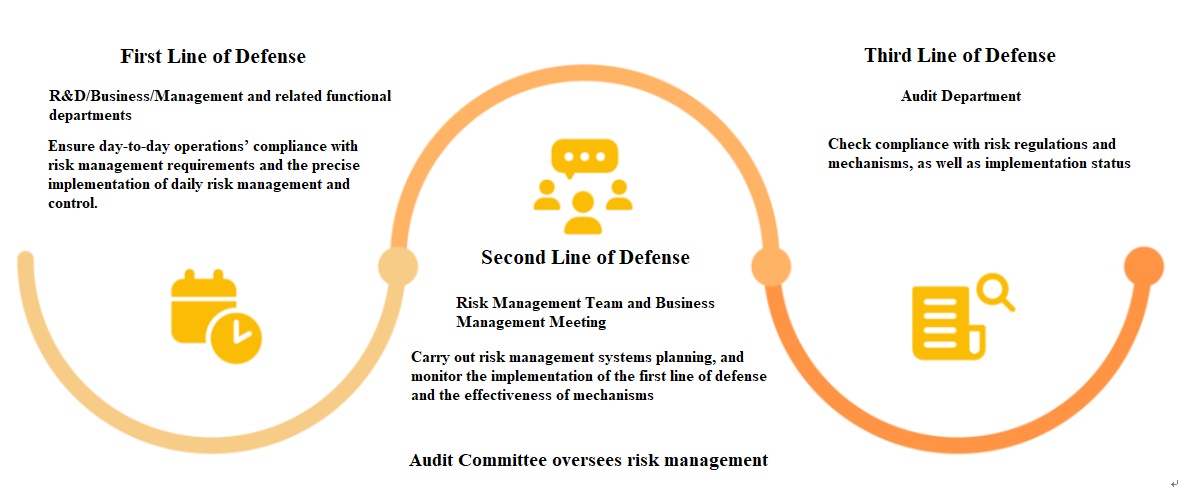|
Risk Control Procedures |
Since 2018, our company has conducted annual risk assessments and submitted reports to the Board of Directors. On July 29, 2021, we established relevant regulations with reference to the "Guidelines for Risk Management Practices of Listed Companies," clearly defining the "Risk Management Policy and Procedures," which was approved by the Board of Directors.
According to the "Risk Management Policy and Procedures," the Risk Management Team convenes representatives from functional units annually to assess and initially screen risks based on the magnitude of their direct or indirect impact on the company. The team then identifies and screens the main risks, compiles and analyzes the results, and submits them to the Management Meeting. The responsible unit for each risk reports its corresponding measures, which are then submitted to the Management Meeting for discussion and approval. The final results are submitted to the Board of Directors by the Chairman's Office.
The risk assessment scope covers all companies within the Group, primarily in Taiwan and mainland China. Risk assessment factors include social, environmental, and corporate governance issues, such as talent, capital, products, market, and environment.
The Company reported its operational status to the Audit Committee and the Board of Directors on August 8, 2025, for the fiscal year 2024. The Audit Committee consists of four members, all of whom are independent directors. The Audit Committee and the Board of Directors are responsible for supervising risk management. Risk assessments are conducted in accordance with procedures, and the management selects significant risk factors, discusses corresponding measures, and then submits them to the Audit Committee and the Board of Directors. The directors' main supervisory focus is on projects such as the continued implementation of carbon reduction and the optimization of cybersecurity.

|
2024 Risk Identification |
Corporate governance:
-
Strategic layout risks: Improve project strategies and reduce the impact of inventory.
-
Market change risk: Due to the impact of international political factors and changes in wafer supply and demand, supply and demand have become more unstable, and we plan to strengthen our relationship with customers and the supply chain.
- Information system risk: such as responding to major issues of information security protection.
-
Operational governance: geopolitical, market changes, and terminal product concentration risks. Responsible units have formulated plans and measures for such risks and reported them to the board of directors.
- We attach great importance to corporate governance and continuously strengthen the functions of the board of directors. The results of the 2024 corporate governance assessment were announced on April 30, 2025, and we have continued to maintain a ranking in the top 6-20%.
- The implementation of corporate governance is listed in "Corporate governance operation status and differences and reasons from the corporate governance practice guidelines for listed and OTC companies".
Social prosperity:
- Human resource risks: Continue to improve employee benefits, share the company's operating performance, initiate key talent retention measures, and strengthen activities to establish values and culture.
- Social care: risks in retaining and nurturing talent.
Sustainable environment:
- Environmental protection risks: In order to comply with SDGs, product specification formulation and technological breakthroughs will be strengthened to develop ICs with lower energy consumption and smaller wafer size.
- Climate change risks, opportunities and responses: Explanation and response to climate change risks, opportunities and responses.
-
Environmental sustainability: the impact of corporate transformation.
-
Our company requires suppliers to comply with RoHS and REACH regulations and implement social responsibility for environmental protection; new supply introduction requires annual audits and reviews to meet quality, cost, delivery and corporate social responsibility requirements. Audit items include: quality system, environmental screening standards (including green product management, ISO14001 environmental safety and health management system verification), social screening standards (ISO 45001 occupational safety and health management system verification), and are included in the evaluation items when evaluating suppliers every year. If they are not met, they will be guided for improvement.
-
Continue to increase localized production (Taiwan or China) to reduce carbon emissions from transportation.
-
Continue to conduct self-inspections of carbon emissions, promote power reduction measures, and complete ISO14064-1 guidance and verification in 2024.
-
Other risk assessments.








